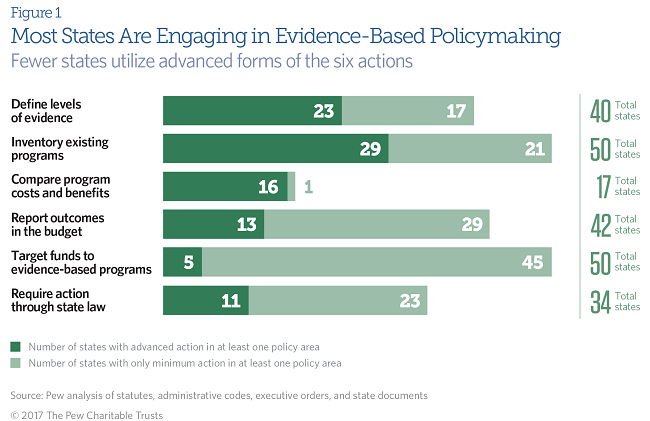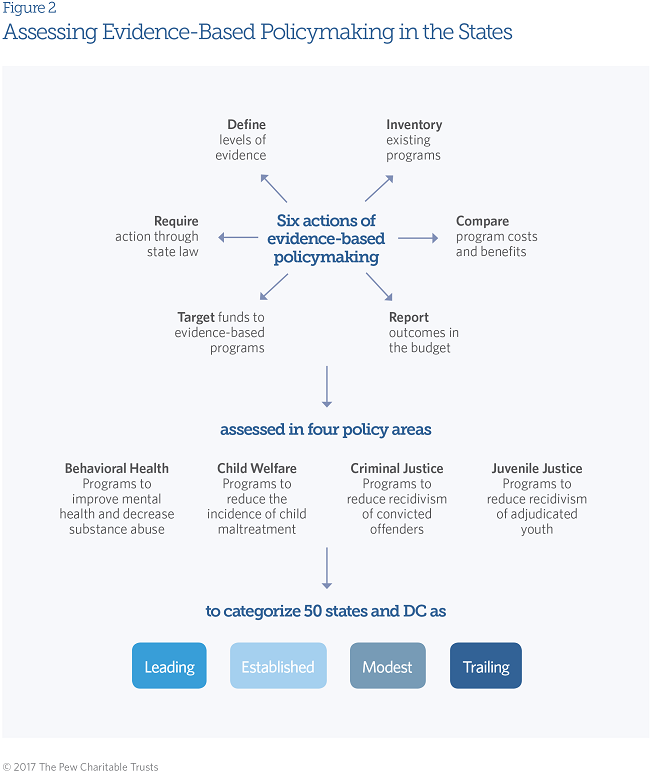Overview
Evidence-based policymaking is the systematic use of findings from program evaluations and outcome analyses (“evidence”) to guide government policy and funding decisions. By focusing limited resources on public services and programs that have been shown to produce positive results, governments can expand their investments in more cost-effective options, consider reducing funding for ineffective programs, and improve the outcomes of services funded by taxpayer dollars.
While the term “evidence-based policymaking” is growing in popularity in state capitols, there is limited information about the extent to which states employ the approach. This report seeks to address this gap by: 1) identifying six distinct actions that states can use to incorporate research findings into their decisions, 2) assessing the prevalence and level of these actions within four human service policy areas across 50 states and the District of Columbia, and 3) categorizing each state based on the final results.
The study finds:
- Five states lead the way in evidence-based policymaking.
- Washington, Utah, Minnesota, Connecticut, and Oregon are leading in evidence-based policymaking by developing processes and tools that use evidence to inform policy and budget decisions across the areas examined.
- 11 states show established levels of evidence-based policymaking by pursuing more actions than most states but either not as frequently or in as advanced a manner as the leading states.
- 27 states and the District of Columbia demonstrate modest engagement in this work, pursuing actions less frequently and in less advanced ways.
- Seven states are trailing, taking very few evidence-based policymaking actions.
- Most states have taken some evidence-based policymaking actions in at least one human service policy area, but advanced application is less common.
- Defining levels of evidence can allow state leaders to distinguish proven programs from those that have not been evaluated. Thirty-nine states and the District of Columbia have defined at least one level of evidence, such as “evidence-based”; 23 of the 40 have created an advanced definition that distinguishes multiple levels of rigor, such as “evidence-based” and “promising.”
- Inventorying state programs can help governments to manage available resources strategically. Forty-nine states and the District have produced an inventory of state-funded programs; 29 of the 50 have created an advanced inventory that classifies programs by evidence of effectiveness.
- Comparing program costs and benefits would allow policymakers to weigh the costs of public programs against the outcomes and economic returns they deliver. Seventeen states have conducted cost-benefit analyses; 16 of the 17 have created an advanced analysis that monetizes benefits to calculate return on investment.
- Reporting outcomes and program effectiveness can help policymakers identify which investments are generating positive results and use this information to better prioritize and direct funds. Forty-one states and the District reported or required key outcome data during the fiscal year 2013-17 budget cycles; 13 of the 42 have created advanced budget materials that include findings from program evaluations.
- Targeting funding to evidence-based programs, such as through a grant or contract, can help states implement and expand these proven approaches. Forty-nine states and the District of Columbia have such a funding mechanism; five of the 50 have created advanced mechanisms to dedicate at least 50 percent of program funds for a specific policy area toward these initiatives.
- Requiring action through state law, which includes administrative codes, executive orders, and statutes, can help states sustain support for evidence-based policymaking. Thirty-three states and the District have developed a framework of laws to support one or more of the five advanced actions listed above in at least one policy area; 11 of the 34 states have created an advanced framework of laws to support two or more advanced actions.

Although many states are embracing evidence-based policymaking, leaders often face challenges in embedding this approach into the decision-making process of state and local governments. This report identifies how staff and stakeholder education, strong data infrastructure, and analytical and technical capacity can help leaders build and sustain support for this work and achieve better outcomes for their communities.

The Results First initiative, a project supported by The Pew Charitable Trusts and the John D. and Catherine T. MacArthur Foundation, authored this publication.
Key Information
Source
Results First™
Publication DateJanuary 26, 2017
Read Time2 min
ComponentProgram Assessment
Resource TypeWritten Briefs
Results First Resources
Evidence-Based Policymaking Resource Center
Share This Page
LET’S STAY IN TOUCH
Join the Evidence-to-Impact Mailing List
Keep up to date with the latest resources, events, and news from the EIC.




